Your lead capture forms are usually the first touchpoint in the sales process for potential leads.
But because forms are often the least guarded, they’ve been the favorite of bad people aiming to exploit the lead capture process.
Dealing with fake leads has become a significant issue for marketers, agencies, and lead generators. They can result in a loss of revenue, tarnish your reputation as a marketer, impact ROI, and throw off your analytics and tracking.
That’s why having a solid knowledge of lead fraud, its common causes, how to spot it, and ways to combat it is a must. I’ll discuss that and provide actionable tips to shield your lead gen forms in this article.
This guide is grounded in my real-world insights from customers over at GetLeadForms, where we’ve helped countless marketers and businesses capture millions of leads with our lead form software.
Let’s dive in!
What is lead generation fraud? How I define it:
You might have seen various definitions of lead fraud before you came here. It’s a term that varies in meaning.
For instance, ActiveProspect defines lead fraud as instances where the provider misrepresents the method of collecting a lead.
But for this discussion, we’ll zero in on lead fraud as the act of submitting fake or fraudulent information through forms. These bogus entries can clutter your database and mess up your analytics.
Now that we’re on the same page, let’s find out the common causes of this fraud we’ve identified.
Common Causes of Lead Fraud
Pipeline Flooding
This tactic refers to the deliberate overload of a lead management system with fake leads. The usual culprit here is your or your client’s competitors.
Pipeline flooding can disrupt sales operations, reduce the sales team’s effectiveness, and ultimately harm the company’s bottom line.
Affiliate Lead Fraud
Affiliate lead fraud can happen when your so-called “partners” in your affiliate program abuse your offer.
They might fill out forms using stolen data or provide leads not interested in your product just to inflate their commission.
Lead Form Exploit
This is the most dangerous act we encounter. It’s when attackers try to manipulate and access sensitive information through phishing schemes or malware attacks.
Remember that all these lead fraud strategies share the same point of entry – your forms. The best way to stop them is by ensuring your lead forms are as secure as possible.
Usual Signs of Fake Leads
Here are the typical and consistent indicators of fake leads I noticed when looking through lead submissions within GetLeadForms.
Odd-Looking Contact Details
Have you ever received lead information that looks strange? Maybe it has an email containing random letters or a phone number with too many zeroes, like this one:
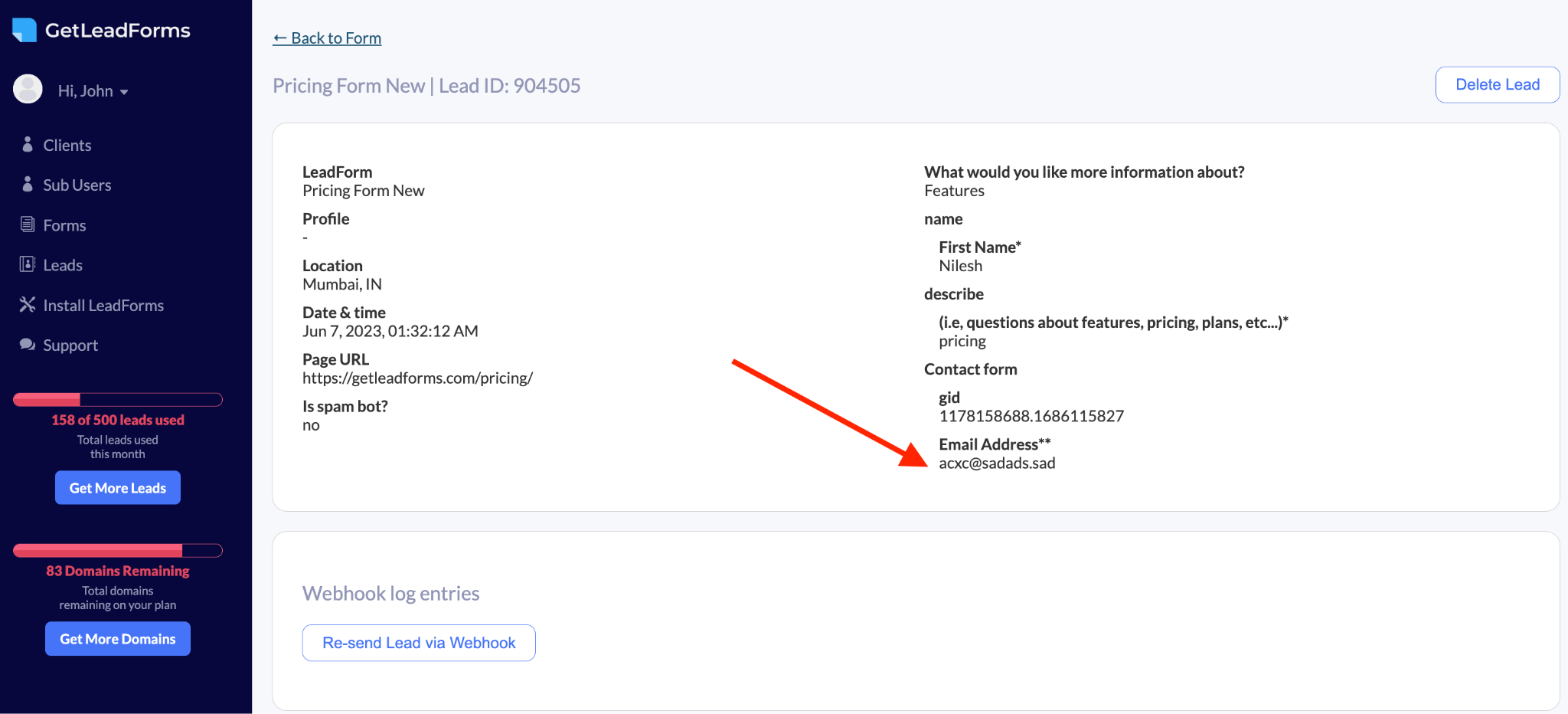
Just with a quick glance, I know immediately that “acxc@sadads.sad” isn’t a genuine lead. But I still checked it and confirmed the site doesn’t exist.
The problem is that this lead made its way into my CRM. It took up space and demanded attention I could have directed towards better leads.
What’s worse is that if an automated follow-up is in place, it can cause emails to bounce and hurt my deliverability, which could impact my ability to reach genuine leads.
Unexpected Patterns in Form Engagement
I’ve noticed that another noticeable sign of whether your lead is authentic is how they answer your forms. Genuine leads take time to read the questions and provide thoughtful responses.
In contrast, fake leads (like the one below) often provide strange or incomprehensible replies. They also usually select the first option in every dropdown menu.
High-Risk Geos
The place where the lead came from can also tell you a lot. Take a look at this form submission.
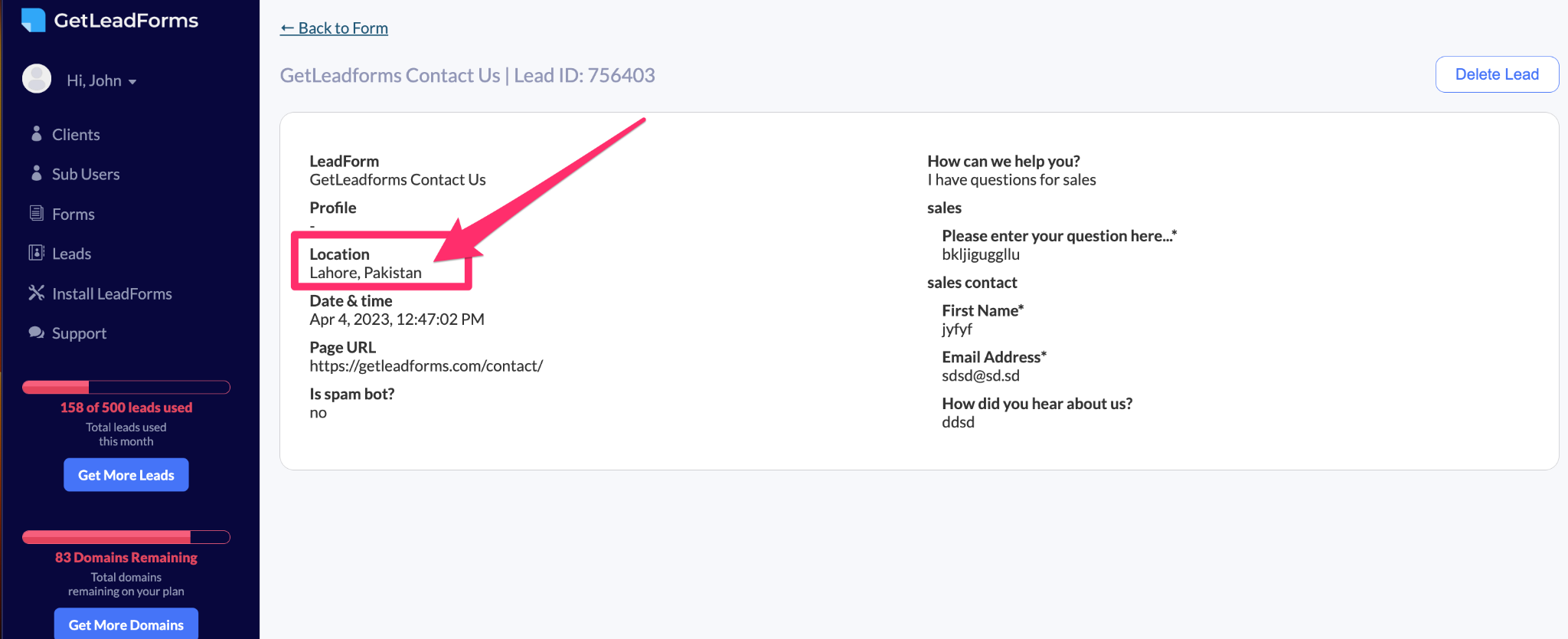
While not all leads from this location are inherently suspicious, I’ve found that it’s essential to be wary of submissions from high-risk geographies such as Pakistan, India, Russia, and other Eastern European countries, which tend to be more known for malicious activity
Here’s another thing. If your or your client’s business targets local markets or specific areas within the USA and you notice leads coming from distant regions, it can indicate potential fraud.
Let’s say you provide leads to a plumbing business in LA. But you start getting form submissions from Moscow or Delhi. This mismatch is a big red flag.
Duplicate IP Submissions
Forms repeatedly submitted from the same IP address and in a short period often imply fraud. Such behavior is uncommon for genuine leads.
It’s a typical attempt to inflate lead numbers or test your form’s security measures.
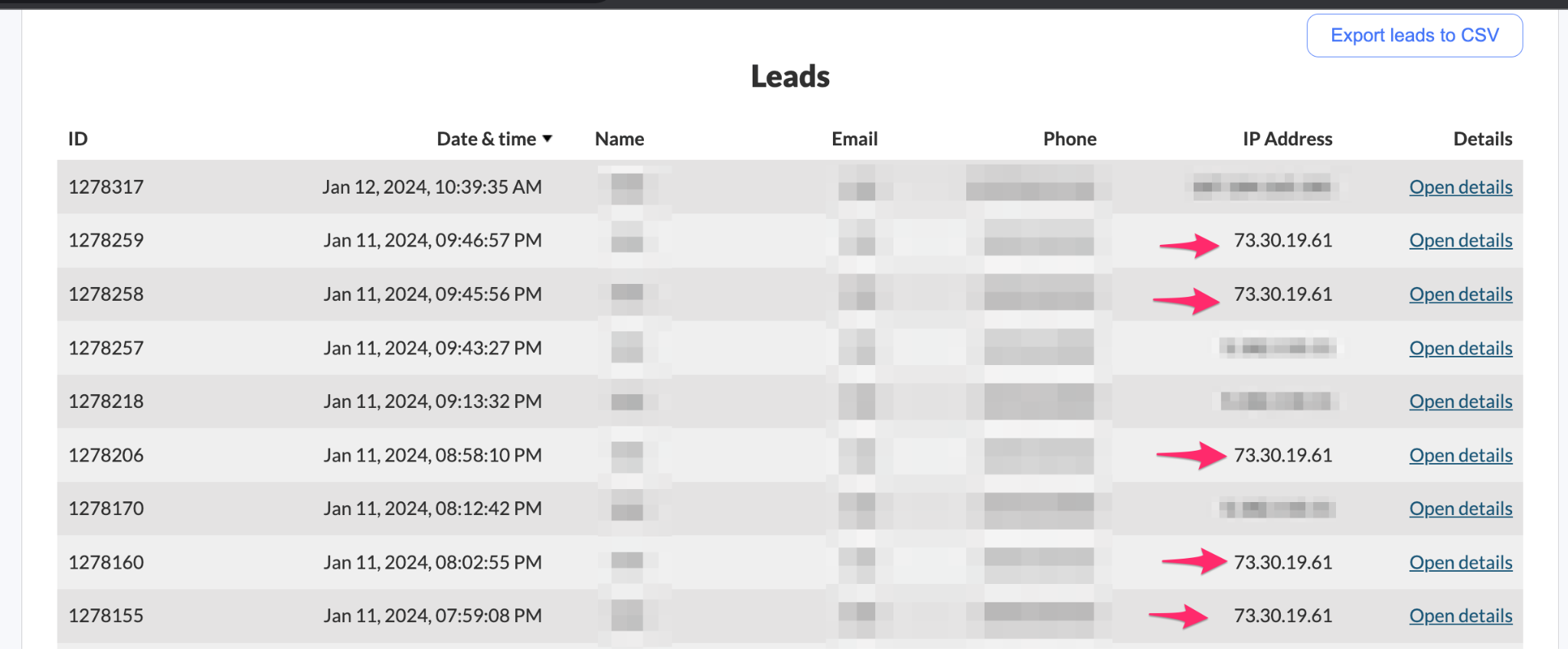
Luckily, this is something GetLeadForms can detect. Like the sample test above, our system tracks IP addresses so we can monitor the IP address for every lead submission to spot these patterns.
Client Complaints and Rejected Leads
Beyond what I’ve shared, listening to your clients, lead buyers, and team members is also essential.
Their experience and direct interaction with the leads can provide valuable insights that may not be visible through checking data alone.
For example, If your client mentions that the leads you sent are unresponsive or low quality, you must take it seriously and investigate further.
Doing this will show your clients that you are committed to meeting the high standards they expect. This will help maintain your effectiveness and credibility as a marketer.
3 Ways to Prevent Lead Fraud
Now that you know the common causes and signs, it’s time to learn how to avoid lead generation fraud. Here are three actionable methods you can follow.
1. Focus on Lead Quality & Intent
You might think that improving the quality of your leads is quite taxing. But it’s not that hard – you just have to ask the right questions in your forms.
For instance, adding non-sensitive Personal Identifiable Information (PII) fields like full name, email, phone number, street address, etc., can decrease the chances of getting fake leads.
In addition, you can also add open-ended fields. Ask your leads to describe their problem or how you can help them. These can add a layer of qualification to weed out or quickly spot fraudulent leads.
You might worry that adding steps to your form could deter potential leads. That’s because the common wisdom suggests that forms should be simple to maximize conversions.
Yet, evidence shows that strategic friction can actually enhance conversion rates.
For example, a B2B software company saw a 20% increase after adding a qualifying step in its lead gen form.
Our favorite way to achieve lead quality is through multi-step forms like the example below:
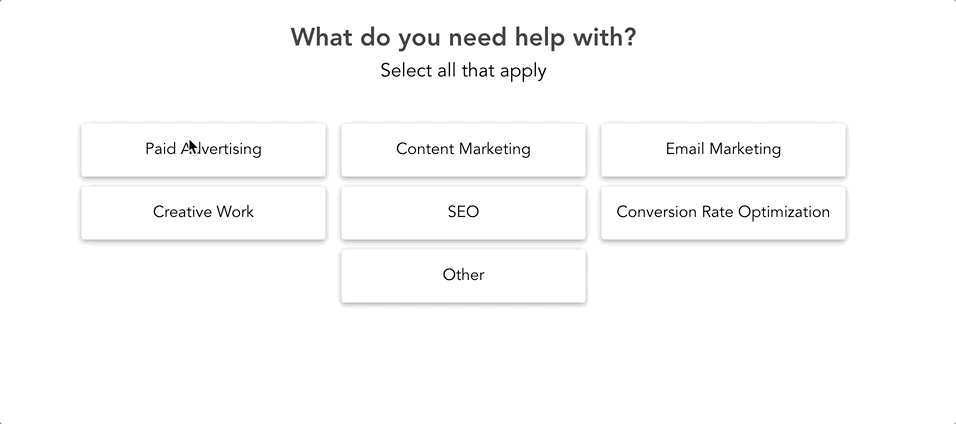
Note: Do you want access to intuitive forms like the one above? Check out our templates.
Breaking down the form into several steps makes it easier for the leads to provide important information. At the same time, you introduce natural checkpoints for lead verification.
Multi-step forms are also flexible. You can use it for home services like plumbing and pest control, mortgage, real estate, insurance, etc.
Let’s say you’re helping a solar company to capture high-intent leads. Adding a field for Zip code before introducing multiple choice questions can set your lead qualification process on the right path from the outset because if you see a bogus zip code come in from a location you don’t serve, you know you have a questionable lead.
 In addition, asking for specific PII details can also help.
In addition, asking for specific PII details can also help.
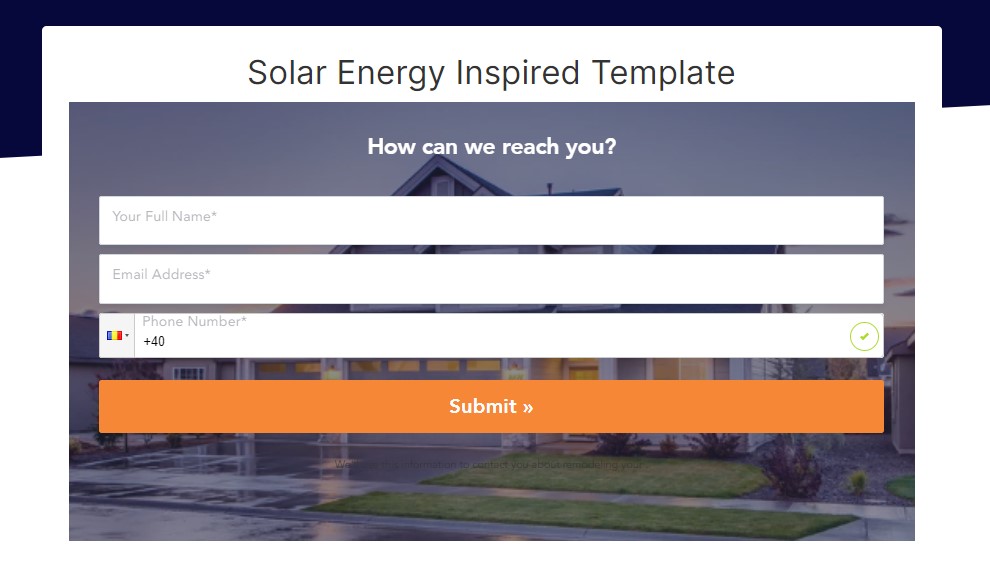
Besides using multi-step forms and adding relevant questions, you can learn more ways to pre-qualify your prospects from this post.
2. Use Google ReCAPTCHA
Adding CAPTCHA to your forms is a proven method to minimize lead generation fraud by putting a barrier that challenges automated bots.
However, what I’ve come to learn is that most marketers don’t want the traditional CAPTCHAs as they can frustrate leads.
They require you to decode distorted text that can be hard to read. That’s why I recommend using Google reCAPTCHA.
Unlike the conventional ones, reCAPTCHA uses more advanced techniques, including image-based challenges with real-world images, like this example below that we built into GetLeadForms:
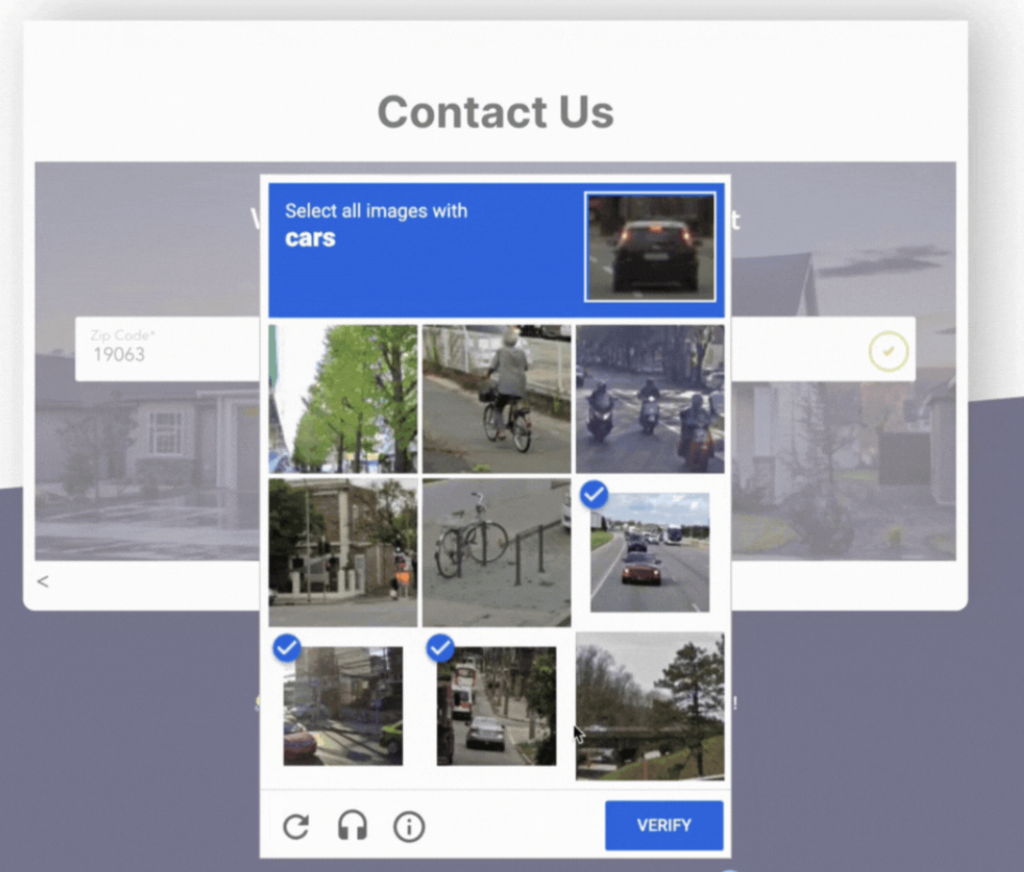
What’s even better about Google reCAPTCHA is that it activates primarily when Google’s algorithms detect suspicious, bot-like behavior.
This means it remains hidden from genuine prospects. So you can provide a smooth and hassle-free experience for individuals filling out your form.
With GetLeadForms, you can integrate this tool directly into our user-friendly forms and ensure your lead generation efforts are protected without compromising user experience.
3. Verify Your Leads
Among the three ways, I could say that lead verification is the most effective in preventing lead generation fraud.
Don’t get me wrong. The first two are great. But you bring your defense against fake leads to the next level if you add this layer.
Lead verification comes in two forms: OTP (One-Time Password) phone and email verification.
OTP allows you to confirm the authenticity of a lead’s phone number off the bat before they can even submit the form. This proactive method saves you (or your clients) from wasting time calling or texting phone numbers that don’t exist.
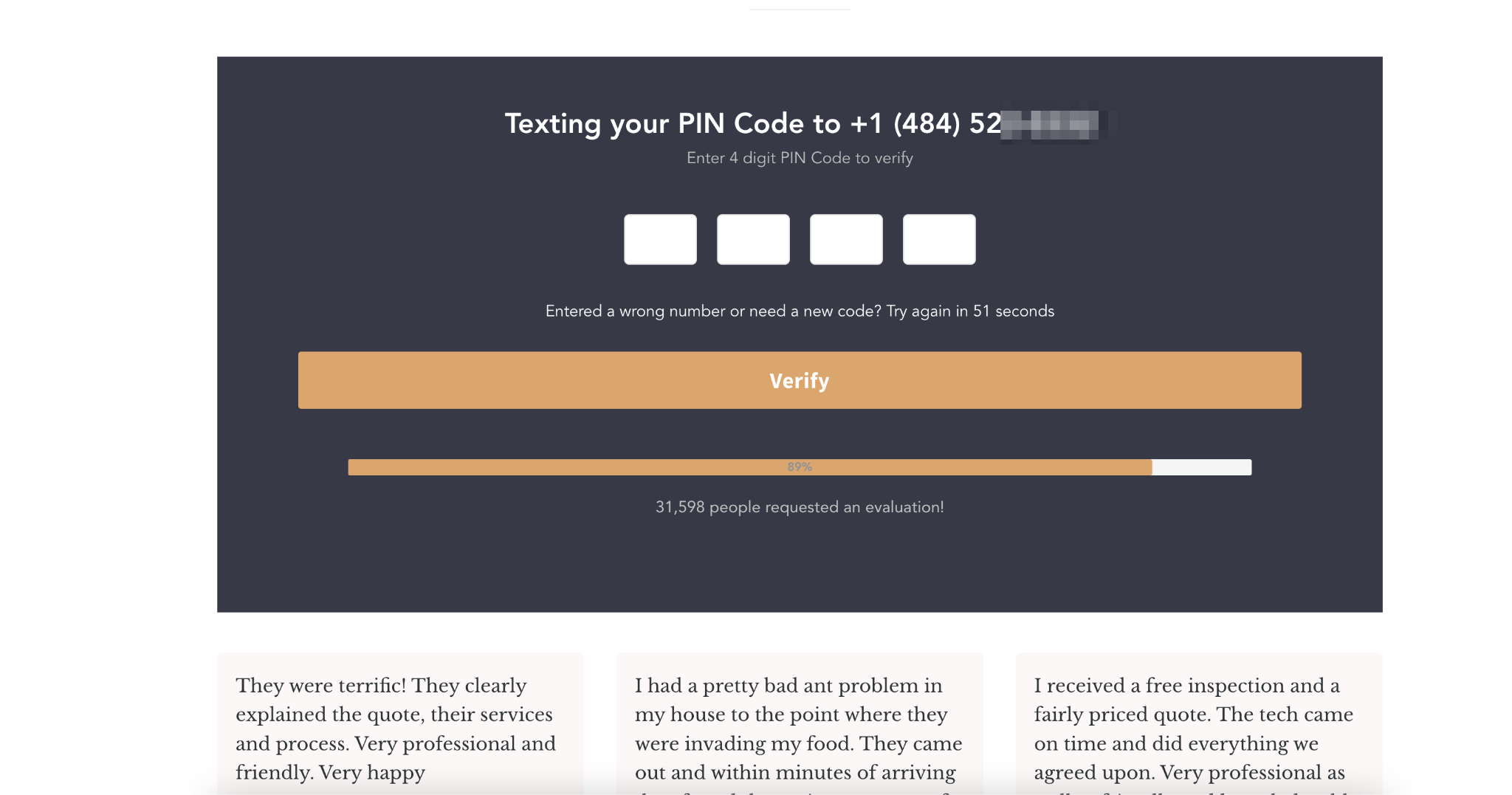
Meanwhile, email verification authenticates the validity and activity level of an email address provided by your lead.
When it comes to email verification, there are two approaches that you can take —real-time email verification and bulk email list cleaning after submission.
Bulk email list cleaning after submission is the most common approach, and this usually consists of running a list of email addresses through an email verification tool like Neverbounce.
The other less common, but more effective approach is real-time email verification in your lead gen forms. With real-time verification, you can actually verify your prospect’s emails directly at the point of entry. This way, you don’t have to worry about fraud leads cluttering up your database and wasting your time to begin with.
I believe in the power of real-time email verification so much that we’re even building this into GetLeadForms as part of our LeadVerify product.
Whether you use these verification methods together or individually, they significantly strengthen your ability to filter out fraudulent leads.
Final Thoughts on Protecting Your Forms From Lead Fraud
Remember, your lead form is the gateway for potential customers but also the best entry point for fraudsters.
Throughout this guide, we’ve explored how to spot suspicious leads and detailed strategies to improve your defense against them.
Let’s quickly recap the three best methods:
- Focus on Lead Quality & Intent. By asking the relevant questions, you can identify low-quality or fake leads and focus on those genuinely interested in your offerings.
- Use Google ReCAPTCHA. This advanced tool can safeguard your forms without discouraging genuine leads.
- Verify Your Leads. OTP phone verification and email verification can provide real-time confirmation of lead authenticity. So you can instantly reduce the risk of fraud.
GetLeadForms has the perfect features if you want the best lead form security and efficiency. Sign up for our free trial to try them firsthand.
If you want more tips on avoiding form spam, you can check out this resource.

